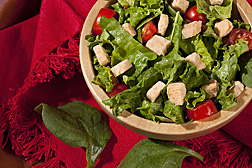A Tale of Freeze-Drying Fish
|
|
Health-conscious consumers are constantly looking for ways to improve their diets, and one way is to eat more fish. For those who don’t have time to bake, broil, or steam fish, a crispy, freeze-dried snack made from salmon may be ideal.
With a little digging, limited supplies of freeze-dried clams, crabs, shrimp, and lobster good for snacks and other meals can be found in some food markets, but even smaller amounts of freeze-dried fish are available. A new method that produces freeze-dried salmon cubes could be used to make tasty snacks, salad toppings, and ready-to-eat soups.
Scientists at the University of Alaska-Fairbanks (UAF), in collaboration with the Agricultural Research Service’s Subarctic Agricultural Research Unit (SARU), which has offices at the Fishery Industrial Technology Center in Kodiak, Alaska, developed a freeze-dry process that produces acceptable food characteristics such as good product color, quick rehydration, and limited shrinkage in less time than the traditional freeze-dry method.
This quicker, less energy-demanding process could potentially be applied to lower value meat components, says ARS food technologist Peter Bechtel, who is located at SARU. Salmon cubes could offer delicious, healthful alternatives for unused portions of fish muscle.
For example, Bechtel says, “sometimes when the salmon gets too close to spawning season, the roe is of high quality and value, but the muscle quality has deteriorated and often has limited uses. Therefore, it’s considered a byproduct; but a freeze-dried product would be a way to use edible portions of meat and add value.”
Freeze-dried salmon products also fit into the recommendations of the 2010 Dietary Guidelines for Americans. For the first time, these guidelines—released in 2011—stress the importance of increasing seafood in the diet, particularly seafood rich in omega-3 fatty acids, such as salmon.
The novel drying process consists of two stages. The first stage involves freezing small cubes of salmon and then putting them into a freeze-dryer to take out a certain percentage of moisture. During the second stage, the product is again put into a dryer to remove the rest of the moisture.
Chuck Crapo, seafood technology specialist with the UAF Marine Advisory Program, and Duy Nguyen, visiting scientist from the University of Nha Trang in Khanh Hoa, Vietnam, used ARS freeze-dryers in Kodiak to establish drying parameters for salmon fillets. The key was to establish a process that would produce freeze-dried cubes with less than 10 percent moisture.
By manipulating temperature and time, Crapo, Nguyen, and UAF professor Alexandra Oliveira created a process that took only 9 hours—traditional processing takes 20 hours or more. About 97 percent of the moisture was removed from fillets of Alaska’s most abundantly harvested Pacific salmon species—pink, sockeye, and chum.
Experiments were conducted using an average of three fillets that were frozen, partially thawed, cut into cubes, arranged into freeze-dry trays, and processed immediately. To reduce the time and remove moisture from the salmon cubes at a faster rate, the temperature during the freeze-drying process was raised from –40˚C to 0˚C.
“We took about 50 to 60 percent of the time off the traditional drying process,” Crapo says.
In addition to requiring a shorter processing time, cubes retained their Pacific salmon color, shrank by only 12 percent, and rehydrated quickly—a desirable trait for use in dry soups.
Bechtel is looking at nutritional quality characteristics of freeze-dried fish through analyses of amino acids and minerals. These findings will be used to identify food products that can be developed for health-conscious consumers.—By Sandra Avant, Agricultural Research Service Information Staff.
This research is part of Aquaculture (#106) and Quality and Utilization of Agricultural Products (#306), two ARS national programs described at http://www.ars.usda.gov/research/programs.htm.
Peter J. Bechtel is in the USDA-ARS Subarctic Agricultural Research Unit, Fishery Industrial Technology Center, 118 Trident Way, Room 126, Kodiak, AK 99615; (907) 486-1531.
"A Tale of Freeze-Drying Fish" was published in the August 2011 issue of Agricultural Research magazine.







